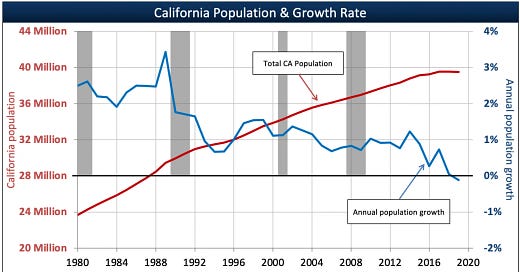Welcome back to The New Urban Order — where urbanists explore the future of cities.
👋🏻 I’m Diana Lind. I’ve been writing about cities for more than 20 years, including in the book Brave New Home.
💻 I post articles to this newsletter twice a week and have more than 100 posts in the archive. About 90 percent of what I publish has a paywall and I save the best insights and commentary for my paid subscribers. If you’re enjoying my newsletter, don’t delay in subscribing.
✈️ I host subscriber-only events in cities around the country and on Zoom. This year, I hosted a two-day event in San Francisco and have one coming up in Philadelphia, plus a quarterly online book club.
❤️ Engagement makes this work possible and fun. If you like a story, don’t forget to hit the like button, share the article and tag me on Substack or LinkedIn, or show some appreciation by subscribing.
After growing nonstop since it became a state in 1850, California saw its first net loss in population in 2020. It eventually would lose more than 400,000 people before posting some meager five-figure gains in 2023. What was once literally the golden state, California had become the poster child of what’s wrong with progressive politics – a toxic combination of high-minded values and NIMBYism that left many parts of the state in paralysis. For example, San Francisco, a city of more than 800,000 people added only 1,200 housing units in 2024, a 12-year low.
But California may be actually turning the corner. Two statewide initiatives this week point to a much brighter future, particularly for housing.
Originally, this post was going to be about how SB 1123 goes into effect today.
SB 1123 makes it legal to build up to 10 homes on vacant lots in single-family zones near jobs, schools, transit, and other amenities, by streamlining the approval process for these projects. Pocket neighborhoods here we come!
This legislation builds upon SB684 which allowed for small developments on multi-family lots. But SB 1123’s focus on single-family lots is critical and provides the framework for rebuilding places like fire-ravaged Los Angeles.
But then the really big news happened overnight.
California Gov. Gavin Newsom just announced a roll back of CEQA on infill housing– the California Environmental Quality Act, which since 1970 has been used as a tool to stop development of all kinds.
CEQA is the epitome of what makes people hate Democrats: it is the asphalt by which we’ve paved the road to hell with good intentions.
As the LA Times notes:
CEQA generally requires proponents to disclose and, if possible, lessen the environmental effects of a construction project. The process sounds simple but often results in thousands of pages of environmental assessments and years of litigation.
As M. Nolan Gray writes, this is the moment that YIMBYs have been waiting for.
This rollback will make building much easier:
Assembly Bill 130, based on legislation introduced by Assemblymember Buffy Wicks (D-Oakland), exempts most urban housing projects from CEQA, requiring only developers of high-rise — taller than 85 feet — and low-income buildings to pay union-level wages for construction workers.
Senate Bill 131 also narrows CEQA mandates for housing construction and further waives the environmental restrictions for some residential rezoning changes. The bill, led by state Sen. Scott Wiener (D-San Francisco), additionally designates a host of nonresidential projects — health clinics, child-care and advanced manufacturing facilities, food banks and more — no longer subject to CEQA.
Experts in development said the new legislation could provide the most significant reforms to CEQA in its 55-year history, especially for urban housing.
California is actually, finally learning from its mistakes. And that’s not just important for the housing and infrastructure it will produce, it’s also important because it shows that blue states are capable of addressing their problems.
So is this the first coming of Abundance movement?







